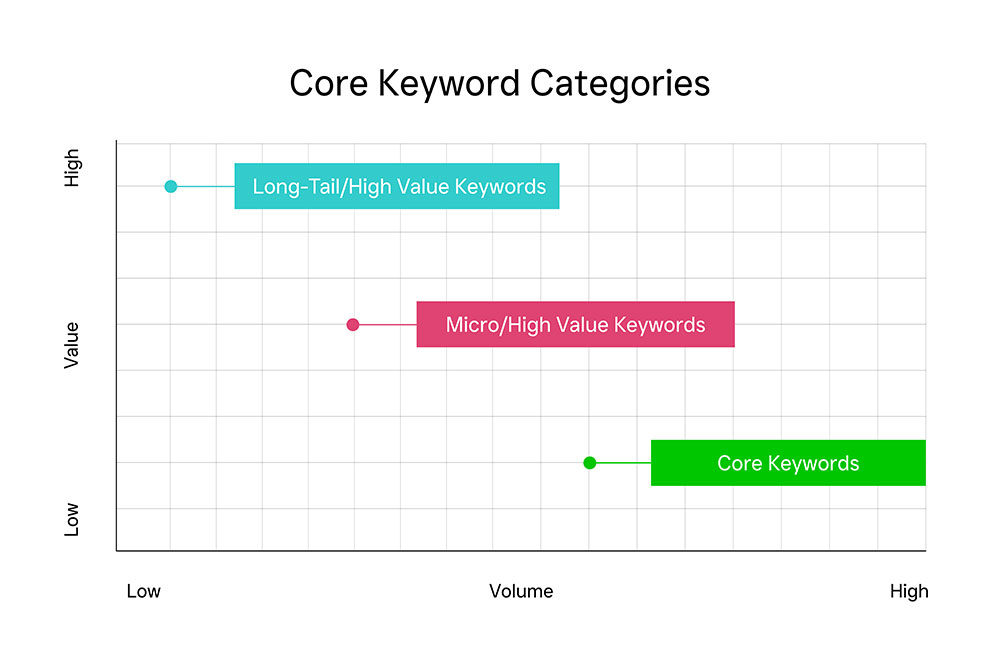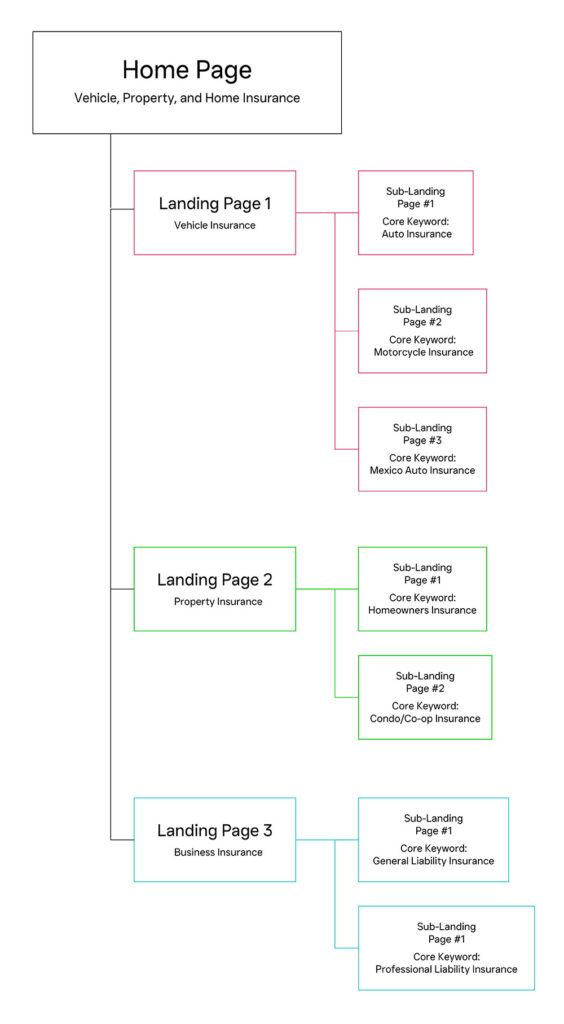Keyword Clustering
Google prefers websites that have a clear organization. One way to achieve this, and at the same time optimize your website for search page rankings, is to organize website pages around a keyword hierarchy.
Keyword hierarchies are created by first identifying core keyword groups (keyword clusters). These groups reflect the keywords searched most often by potential customers and are most likely to lead to a transaction for your company’s basic products or services.
Leading a core keyword group is a parent (sometimes called “head”) keyword. A parent keyword has a minimum number of words necessary for a logical search and is often more than one word. It normally includes the name or statement for a company’s products and services. For each company there are normally several parent keywords. An example would be GEICO insurance where, among others, vehicle and property insurance are important products.
Next, for each parent keyword, identify the most important helper words that are often searched with the core keyword. These include terms such as best or top-rated, or terms related to geography, such as a city or near me.
Using the parent/core keywords and helper words, summarize the key phrases being searched by potential customers. For example, GEICO’s parent keyword property insurance, is followed by a family of services, such as home insurance, best home insurance, condo insurance, condo insurance company, renter’s insurance, etc.
The family keyword phrases are grouped as clusters with their respective parent core keyword. Using tools such Semrush, Ahrefs, or Google Keyword Planner, determine the search volume for each phrase. Once you have identified the volume associated with each keyword, using the same tools, learn whether each parent keyword and family keyword phrases are of high value (Searcher has a high intent to purchase.), low value (Searcher is researching and has a low likelihood to purchase.), or negative value (Searcher is seeking information and has no intent to purchase. You would be wasting your advertising dollars on this keyword.)
When assessing the volume and value associated with core keywords, look for those that have sufficient volume and a sufficient value that will lead to a customer sale. These can be categorized as:
Core keywords that have acceptable levels of volume and sufficient value to turn into a transaction.
Micro/high value keywords. These are niche keywords (one to two words) that have a low volume, but high value and are very likely to lead to a sale. (For example, “gold watch”)
Long-tail/high value keywords. Long-tail keywords are generally three to five words. Collectively, the words are more specific and allow you to target more niche categories, products, or services where keyword volume is relatively low but the value (likelihood of a transaction) is high. (For example, “hot pink beaded headbands.”)

Now with both volume and value identified for each keyword phrase, it is important to assess the level of competition for each. Semrush and others provide scores for the level of difficulty to rank for specific keywords.
With volume, value, and competitive research completed, prioritize your keyword families (parent keyword and keyword phrases) from top to bottom and organize them in categories such as hot, warm, and cold.
Top keyword phrases (hot) would include those where keyword volume and value are high and competitive difficulty is low. Other priority keywords would include those where volume is low, but value (likelihood of a transaction) is high and competitive difficulty is low. Keywords that have low volume and low value, with high difficulty would not be pursued (cold).
When completed, you should be able to identify five to ten core keyword parent groups with family keywords (clusters) that can form the basis for your website’s hierarchy. At the same time, when thoughtfully used within your website (on-page SEO), the keyword phrases will increase your site’s authority with Google and lead to higher organic search page rankings.
Within the hierarchy, each core keyword should lead to one landing page on your website followed by sub-landing pages related to keyword phrases. Note: An e-commerce website might have hundreds, but the same principles apply; one core keyword aligns with one landing page.
One company that has organized its website around core keyword groups and micro-high value keywords is GEICO. This insurance company has landing pages for core keyword groups and phrases including: vehicle insurance, auto insurance, motorcycle/ATV insurance, property insurance, homeowners insurance, and business insurance. It also has individual pages for more niche, high value keywords like Mexico auto insurance, vehicle insurance for tourists driving in Mexico, collector & classic car insurance, and insurance for a vintage, antique, or collectable car.

The website hierarchy for GEICO looks like this.
Home Page: Vehicle, Property, and Home Insurance
- Landing Page 1: Vehicle Insurance
- Sub-landing page #1 (core keyword – Auto Insurance)
- Sub-landing page #2 (core keyword – Motorcycle Insurance)
- Sub-landing page #3 (core keyword – Mexico Auto Insurance)
- Etc.
- Landing Page 2: Property Insurance
- Sub-landing page #1 (core keyword – Homeowners Insurance)
- Sub-landing page #2 (core keyword – Condo/Co-op Insurance)
- Etc.
- Landing Page 3: Business Insurance
- Sub-landing page #1 (core keyword – General Liability Insurance)
- Sub-landing page #2 (core keyword – Professional Liability Insurance)
- Etc.
- Additional Insurance
- Sub-landing page #1 (core keyword – Pet Insurance)
- Sub-landing page #2 (core keyword – Jewelry Insurance)
- Etc.
With this research and development for your website’s hierarchy, SEO is further improved in a number of ways. Notably, keywords within each page will match the search intent of your target audience. Additionally, each page’s content will thoughtfully serve the informational needs and user experience of your audience.
Cheers! to keyword clustering and forming website hierarchies optimized for SEO.
Sources: Jason McDonald, SEO Work Book 2023, LinkedIn, “How Can Keyword Clustering Optimize Your Website?”, Semrush, “How to Do Keyword Clustering & Why It Helps SEO,” May 15, 2023.


